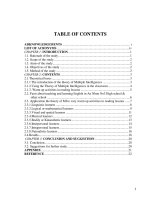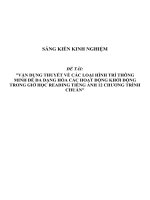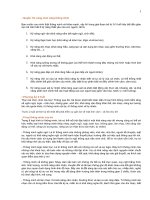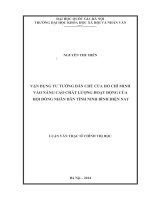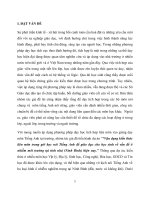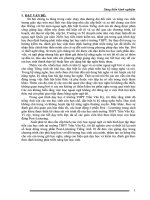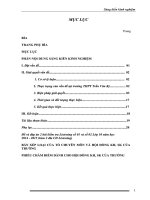Vận dụng Thuyết về các loại hình trí thông minh để đa dạng hóa các hoạt động khởi động trong giờ học Reading- tiếng Anh 12 chương trình chuẩn
Bạn đang xem bản rút gọn của tài liệu. Xem và tải ngay bản đầy đủ của tài liệu tại đây (10.64 MB, 38 trang )
TABLE OF CONTENTS
ADKNOWLEDGEMENTS .................................................................................. i
LIST OF ACRONYMS ........................................................................................iv
CHAPTER 1: INTRODUCTION ...........................................................................1
1.1. Rationale of the study .......................................................................................1
1.2. Scope of the study.............................................................................................2
1.3. Aims of the study..............................................................................................2
1.4. Objectives of the study .....................................................................................2
1.5. Method of the study ..........................................................................................2
CHAPTER 2: CONTENTS.....................................................................................3
2.1.Theoretical bases ...............................................................................................3
2.1.1 The introduction of the theory of Multiple Intelligences .................................3
2.1.2 Using the Theory of Multiple Intelligences in the classroom...........................4
2.1.3. Warm up activities in reading lessons ............................................................5
2.2. Facts about teaching and learning English in An Nhơn No3 High school &
other school .....................................................................................................6
2.3. Application the theory of MI to vary warm up activities in reading lessons ......7
2.3.1.Linguistic learners ..........................................................................................8
2.3.2.Logical or mathematical learners ....................................................................9
2.3.3.Visual and spatial learners ............................................................................11
2.3.4.Musical learners............................................................................................12
2.3.5.Bodily or Kinaesthetic learners .....................................................................13
2.3.6.Interpersonal learners....................................................................................14
2.3.7.Intrapersonal learners....................................................................................15
2.3.8.Naturalistic learners ......................................................................................16
2.4.Results.............................................................................................................18
CHAPTER 3: CONCLUSION AND SUGGESTION .........................................20
3.1. Conclusion......................................................................................................20
3.2. Suggestions for further study ..........................................................................20
APPENDIX ..........................................................................................................21
REFERENCE ......................................................................................................22
1
TÓM TẮT NỘI DUNG SÁNG KIẾN KINH NGHIỆM
Tên đề tài: APPLYING THE THEORY OF MULTIPLE
INTELLIGENCES TO VARY WARM UP ACTIVITIES IN
READING LESSONS - TEXTBOOK TIENG ANH 12
Written by : Nguyễn Thị Thanh Huyền
I .Mục đích của đề tài:
Giúp giáo viên Tiếng anh hiểu thêm về hiệu quả của thuyết vế các loại
hình trí thơng minh trong giảng dạy Tiếng Anh.
Tạo ra nhiều hoạt động warm up giúp cho các giờ dạy đọc hiểu thêm sinh
động và đạt hiệu quả
Thu hút sự hứng thú của mọi đối tượng học sinh trong giờ học Tiếng Anh
II. Bản chất của giải pháp
1.6.Design of the study
The study consists of 4 main chapters:
- Chapter 1 is the introduction which deals with the rationale, the
scope, the aims, the method and the design of the study.
- Chapter 2 is the literature review of the study. In this chapter, I
will introduce specific features of the theory of MI,the application into
classroom, the roles of warm up activities in teaching reading lessons and
the facts of learning and teaching English in An Nhon No3 High School
- Chapter 3 is the activities. In this chapter, lots of warm up
activities are suggested and applied in real lessons
- Chapter 4 is the conclusion, the implications for teaching,
learning and suggestions for other researches.
At the end of the study, there will be the presentation of reference
materials used to carry out the study.
2
CHAPTER 1
INTRODUCTION
1.1. Rationale of the study:
Recent years have seen remarkable changes in the way of teaching
English. However, although teachers of English have adopted
communicative approach for a few years, they find it difficult to teach all
kinds of students in the same class effectively. Students tend to be treated
as a homogeneous group and find no where to show their strength in the
classroom. The term “students-centered” seems to be completely ignored.
In fact, every classroom is full of students who are different from each
other in many different ways. A student is unique in a class not only
because of his age, his family background, or his own interests, but also
because of his strengths and weaknesses. It is undeniable that when
students learn through their strengths, they not only learn more effectively
but also show the improvement in their weaker areas. In addition, the
theory of Multiple Intelligences maintains that students who have one area
of intelligence which is more fully developed than the others should be
encouraged to approach their learning by using that particular intelligence
as an entry point. As a result, it is vital for teachers to utilize such
strengths or intelligence of students to help them absorb the knowledge in
the most suitable way. With the hope to find a better way to teach students
as individuals, this experienced idea, based on the theory of Multiple
Intelligences, has been carried out.
In addition, reading is one of the most basic skills that need paying
much attention in the teaching and learning process of a foreign language.
Reading skill is not only the purpose of the learning process but also an
effective means for students to expand their vocabulary and structures;
thus, helps them to improve other skills. Moreover, in 12 years in the job
as a teacher of English, I recognize that most of the students consider
reading as a boring skill; therefore, they soon become fed up with the
reading passages in their textbook. Hence, I harbour the wish of helping
students improve their reading skills in this experienced idea.
Last but not least, warm-up activities are excellent teaching tool in
motivating students when they first come to the new lesson. It is clear that
3
starting a lesson with a good warm-up activitiy helps to captivate the
students and draws them into the lesson well. From my experience, it isn’t
difficult to carry out a warm-up activity, but it is quite easy to repeat this
kind of activity, which makes it boring. Thus, to make an effort to vary
warm-up activities, I carry out this idea.
From the above discussion, my experienced idea will make a little
contribution in applying the Theory of Multiple Intelligence to vary warmup activities in reading lessons.
1.2. Scope of the study
In spite of having been studied only for recent years, the theory of MI
has exposed its importance in analyzing psychological aspects in human’s
intelligences. Thanks to its significance, methodologists have applied the
theory into teaching foreign languages and gained certain success. In
teaching English, this theory has provided some theoretical backgrounds in
creating various activities that attract students’interests. However, with the
limitation of time and reference materials as well as the limited level of
this study, my study focuses only on warm up activities used in reading
lessons in textbook Tieng Anh 12. In this study, I shall be concerned with
making students of different levels to be much interested in the topic at the
beginning of reading lessons
1.3. Aims of the study
This study is carried out with the following specific aims:
- To make teachers more aware of the importance and effectiveness
of the theory of MI in teaching English
- To create various warm up activities to make reading lessons
more interesing and effective
- To attract the interests of all kinds of students in an English lesson.
1.4. Objectives:
I have carried out this study to the students in grade 12, acedamic
year 2009 – 2010 and 2010 - 2011 with textbook Tieng Anh 12
1.5. Method of the study
In order to achieve the aims of the thesis, I have followed the
following steps:
- Make a small survey about the interests of students in a reading
lesson
- Collect, create, classify and apply variety of warm up activities to
see their levels of effectiveness in reading lessons
4
- Observe students’ reactions in differents kinds of warm up
activities, and then draw some conclusions on their most favorite warm-up
activities.
- Classify students in each class and use suitable activities.
5
CHAPTER II
CONTENTS
2.1. THEORETICAL BASES
2.1.1. THE INTRODUCTION OF THE THEORY OF MULTIPLE
INTELLIGENCES
Have you ever thought about why your students react in different ways to
the activities you do in the class? Or even why different groups react differently
to the same activity? Why do some students really enjoy working in groups
while others are much more productive working alone? Why do some learners
draw pictures in their vocabulary books while others seem to need to just hear a
word to be able to use it themselves?
Dr. Howard Gardner-professior of education at Harvard University (the
photo above) developed a theory called Multiple Intelligences (1983) which can
go some way towards explaining different learner styles.
According to Gardner, there are eight different types of intelligences as
followed:
Linguistic intelligence- The word-player. This area of intelligence has to
do with words, spoken or written. Students who have this type of
intelligence tend to be typically good at reading, writing, telling stories
and memorizing words along with the dates. They tend to learn best by
reading, taking notes, listening to lectures, and by discussing and debating
about what they have learned. Moreover, students with this type of
intelligence find it is very easy to learn a foreign language because they
6
have high verbal memory to recall, understanding and manipulate syntax
and structure. In the most traditional sense, the teacher teaches and the
students learn. However, this can also be turned around and students can
help each other understand concepts. .
Logical / Mathematical intelligence- The questioner –This area of
intelligence has to do with logic, abstractions, reasoning and numbers. In
other words, this is the use of logic and mathematical models to represent
and work with ideas. While it is often assumed that those with this
intelligence naturally excel in mathematics, chess, computer programming
and other logical or numerical activities, a more accurate definition places
less emphasis on traditional mathematical ability and more on reasoning
capabilities, recognizing abstract patterns, scientific thinking and
investigation and the ability to perform complex calculations. It correlates
strongly with traditional concepts of "intelligence" or IQ.
Visual / Spatial intelligence- The visualiser- This is the explanation and
comprehension through the use of pictures, graphs, maps, etc.This type of
learning gives students visual clues to help them remember language. In
my opinion, the use of visual, spatial and situational clues is probably the
most effective way to learn English.
Musical intelligence- The music lover- This is the ability to recognize and
communicate using melody, rhythm, and harmony.This type of learning is
sometimes underestimated in ESL classrooms. If you keep in mind that
English is a very rhythmic language because of its tendency to accent only
certain words, you'll recognize that music plays a role in the classroom as
well.
Bodily / Kinaesthetic intelligence- The mover- This is the ability to use
the body to express ideas, accomplish tasks, create moods, etc.This type of
learning combines physical actions with linguistic responses and are very
helpful for tying language to actions. The students of this type may enjoy
acting or performing, and in general they are good at making or building
things. They often learn best by doing something physically, rather than
by reaing or hearing about it. In other words, repeating "I'd like to pay by
credit card." in a dialogue is much less effective than having a student act
out a role-play in which he pulls out his wallet and says, "I'd like to pay by
credit card."
Interpersonal intelligence- The socialiser –This is the ability to get along
with others, work with others to accomplish tasks. Group learning is based
7
on interpersonal skills. Not only do students learn while speaking to others
in an "authentic" setting, they develop English speaking skills while
reacting to others. .
Intrapersonal intelligence- The loner – this is a way to learn through
self-knowledge leading to understanding of motives, goals, strengths and
weaknesses.This intelligence is essential for long-term English learning.
Students who are aware of these types of issues will be able to deal with
underlying issues that can improve or hamper English usage.
Naturalistic intelligence- The nature lover (added by Gardner at a later
date) - This is the environmental ability to recognize elements of and learn
from the natural world around us. Similar to visual and spatial skills,
Environmental intelligence will help students master English required to
interact with their environment.
The drawing on the next page can best illustrating the eight different types of
inteligences:
8
The eight different types of intelligences
9
2.1.2 USING
CLASSROOM
THE
MULTIPLE
INTELLIGENCE
IN
THE
Everyone is born possessing the eight intelligences. Nevertheless, all students
will come into the classroom with different sets of developed intelligences.This
means that each child will have his own unique set of intellectual strengths and
weaknesses. These sets determine how easy (or difficult) it is for a student to
learn information when it is presented in a particular manner. This is commonly
referred to as a learning style. Many learning styles can be found within one
classroom. Therefore, it is impossible, as well as impractical, for a teacher to
accommodate every lesson to all of the learning styles found within the
classroom. Accepting Gardner's Theory of Multiple Intelligences has several
implications for teachers in terms of classroom instruction. The theory states that
all eight intelligences are needed to productively function in society. Teachers,
therefore, should think of all intelligences as equally important. This is in great
contrast to traditional education systems which typically place a strong emphasis
on the development and use of verbal and mathematical intelligences. Thus, the
Theory of Multiple Intelligences implies that we should recognize and teach to a
broader range of talents and skills. Another implication is that teachers should
structure the activities in a style which engages most or all of the intelligences.
This kind of presentation not only excites students about learning, but it also
allows a teacher to reinforce the same material in a variety of ways. By
activating a wide assortment of intelligences, teaching in this manner can
facilitate a deeper understanding of the topic of the lesson.
2.1.3 WARM UP ACTIVITIES IN READING LESSONS
It has been known for some time that students learn best when:
Learning is fun or pleasurable. One effective way of motivating a student
is to have them undertake activities for which the student has some talent. With
progress, the student avoids undue frustration and goes on to learn more.When
application of Multiple Intelligence theory is made in this way teachers are
“teaching through a child’s strength.
They are emotionally involved students learn, remember and are more
likely to use experiences that are troubling, mystifying or off-putting as well as
ones that are pleasurable. Students are “turned off” or “on” very quickly, so a
memorable opening illustration or attention-grabbing comment helps engage
10
their minds. MI provides a plenty of ways to broach a topic, one of which the
students are sure not to have experienced previously.
They are challenged. Students will not adopt new strategies in learning
unless they are challenged. Traditional methods of teaching a student who has
failed to learn the first time, is to repeat the same experience. MI theory would
teach students through their strength; the content does not need to be
downgraded.
They become so absorbed in a physical or mental activity that they
temporarily lose track of space, time, worldly concerns and even pain. Teaching
through a student’s strength allows the student to get involved, in-depth in a
subject. It also motivates a student for further learning.
They are enveloped within (classroom or home life or both) an atmosphere
of continual improvement - a cycle of practise, learning and expression.
As English teachers, we hope our students will take an active part in the
classroom. It is our duty to make the classroom a lively and interesting place.
How can we create such a classroom? My experience has taught me that warmup activities can spark students’ curiosity and promote a comfortable
atmosphere.
Warm-up activities are activities or games carried out at the beginning of
each class to motivate students so they can make good use of class time. In fact,
these initial activities that start the class are very important for some reasons.
First of all, warm ups set the tone of the lesson. For example, a fun activity can
raise energy levels at the beginning of the lesson while an activity that students
find too difficult or confusing can prove discouraging. Secondly, warm ups get
students to begin thinking and focusing on English.Thirdly, warm ups provide a
transition into the topic. It is true that an activity at the start of the lesson
activates pre-existing knowledge on a subject, and may even get students to use
(or consider) some of the ideas, vocabulary, or even grammar important to the
lesson. Finally, they allows the teacher important opportunities to access
character and ability. Thus, during the activities, the teacher can know which
students work well together and which ones don’t so that he can determine who
will form the best groups for subsequent activities.
In a reading lesson, a good warm-up activitiy is one that grabs
students’attention and acts as a transition between the previously taught skill and
the one to follow. In addition, it is in the reading sections that students first come
to the lesson’s topic which is often new and contains variety of new words and
expresions. As a result, it is advisable for teachers to create interesting warm-up
11
activities so that students can get themseves ready to deal with difficult tasks in
reading passages.
2.2. FACTS ABOUT LEARNING & TEACHING IN AN NHON No3
HIGH SCHOOL & OTHER SCHOOLS
Dr. Gardner says that our schools focus most of their attention on
linguistic and logical-mathematical intelligence. We esteem the highly articulate
or logical people of our culture. However, Dr. Gardner says that we should also
place equal attention on individuals who show gifts in the other intelligences.
Unfortunately, many students who have these gifts don’t receive much
reinforcement for them in school. Many of these students, in fact, end up being
labeled "learning disabled,"
Having taught English for 12 years, I have gained some experience and
had a deep look into unavoidable problems of teaching English at An Nhon No3
High School as well as others. The most easily recognized problem is that many
teachers of English usually go directly into their new lesson without warm-up
activities. This results in boring learning atmostphere and students find it
difficult to learn with their enthusiasm. And if some warm-up activities are done,
they are just small games which make students feel “funnier” while the content
of the new lesson is ignored. Moreover, it is also a problem that most teachers of
English have tried their best to create interesting warm-up activities only to
attract the attention of good students. Weaker students, in contrast, become their
audiences or fans. As a result, although warm-up activities are done, they fail to
motivate all the students. This is really worth considering when the number of
weak students is still high. More importantly, many teachers of English usually
apply the same warm-up activities to every kind of class and students, which is
not flexible at all. The levels of students are not paid much attention to. Most
importantly, the term “multiple intelligences” seems to be unfamiliar to most
teachers of English. They even don’t know what they are and how to apply them
to vary their warm-up activities in order to motivate their students. Hence, I
think it is high time for us to do something to make the theory of multiple
intelligences become practical and applicable in the way we teach English.
12
2.3. APPLICATION THE THEORY OF MI TO VARY WARM UP
ACTIVITIES IN READING LESSON
The theory of multiple intelligences suggests that teachers be trained to
present their lessons in a wide variety of ways using music, cooperative learning,
art activities, role play, multimedia, field trips, inner reflection, and much more.
In fact, teachers usually approach MI from two directions. Some teachers plan
lessons teaching content through each intelligence. Other teachers plan their
lessons around the strengths and weakness of their student’s MI profiles. MI
educationists generally prefer the later approach, as it encourages teaching weak
students through their strengths. Teachers find that teaching through strengths
develops a student’s weaker intelligence. Therefore, students should be
encouraged to use their strengths in order to make the learning process more
accessible.
Although the students’ feedback confirmed that warm-up activities are a
creative teaching tool, we need to adopt appropriate activities. If the activities are
too difficult, the students cannot do them; but if the activities are too easy, the
students do not improve their English and may lose interest. Therefore, it is
always better to link each short activity to what the students are studying.
At the beginning of reading lessons, I try to use various warm up activities
so that I can touch upon all the types of intelligences now and again. By
observing my students and making notes on how they react to different activities
I may well discover, for example, that I have a class with a majority of visual
learners so I try to use more flash cards or improve my board work.
Corresponding to different kinds of intellignces, I have classified into 8
types of learners with some suggested warm up activities as followed:
2.3.1. Linguistic learners :
These are learners who are good at reading, writing, and telling
stories and who can learns best by saying, hearing and seeing the
words
Suggested activites: Chain Stories, Categories, Memory games, Running
Dictation
Applied in real lesson
MEMORY GAME
13
( Applied in Unit 10: Endangered Species, A- Reading)
Kind of activities: linguistic
Levels of students: medium and weak students
Kinds of intelligence touching: linguistic, interpersonal, visual
Preparation: Two separate pieces of paper with some phrases
related to the topic of the reading text. The first part of each phrase
should be written on one coloured sheet of paper or, if you haven't
got coloured paper, in a different coloured pen. Then with a
different coloured pen, or paper, write the second part of the phrase,
for example, 'ozone' on the first and 'layer' on the second.
Procedure:
Put all of the first parts of each phrase together, face down on
the floor. Then mix up the second group of words / phrases face
down in a separate group to the first.
In groups students work together to pick up one piece of paper
from each group so as to make a phrase from the previous class.
As the students match them up incorrectly students start to
recall the correct collocation or phrase.
The activity is not only fun but also aids efficient memorising
of the target language. The more opportunities we allow our
students to see the words the more likely they are to actually
have them 'stuck in their heads' for easy access at a later stage.
Cut down
Endangered
Raise
Over
Contaminate
Species
Enact
Habitat
trees
species
awareness
hunting
water
diversity
law
destruction
RIGHT OR WRONG? RIGHT OR LEFT?
( Applied in Unit 15: Women In Society, A: Reading)
Kind of activities: linguistic
Levels of students: medium and advanced students
14
Kinds of intelligence touching: linguistic, spatial, interpersonal,
intrapersonal
Preparation: some sentences in the reading text or relating to the
content of the reaing text.
Procedure
Line up the class in a row facing the teacher.
Say a sentence which relating to the reading text and students
have to decide if the sentence is right or wrong. For example,
“ Many people believed that women’s natural roles were as
mothers and wives “or “ Women are usually better with children
than men”
If the sentence is right students should take a big step to the right.
If it's wrong, they should take a big step to the left.
When the students get the idea, one of them can make up the
sentences.
The last person to step, or the students who step the wrong way,
can be eliminated
2.3.2. Logical or mathematical learners:
These are learners who are good at solving puzzles, exploring patterns,
reasoning and logic and who can learn best by asking questions, categorising and
working with patterns.
Suggested activites: Puzzles, Problem solving,Mastermind
Applied in real lesson
TOPIC WORD
( Applied in Unit 7: Economic Reform, A:Reading)
Kind of activities: logical
Levels of students: medium students
Kinds of intelligence touching: linguistic, logical, interpersonal,
intrapersonal.
Preparation: 2 blank worksheets ,a slide with a set of words in
random order of letters
15
1. ducprotion
2. tryindus
3. mentplovede
4. culagriture
5. porext
6. mentgonver
7. wal
8. bunisess
Procedure :
Divide the class into 2 teams
Show the slide and ask the sts to read in one minutes
Ask students to write all the words in the correct order (1.
production. 2. industry, 3.development, 4. agriculture, 5. export,
6. government, 7. law, 8. business.
While writing, asks them to predict the topic word of all these
words “ ECONOMY”
One word in correct order gets 1 mark, topic word gets 5 marks
Correct, tell the winner and ask students to tell something about
Vietnamese economy nowadays.
Lead into the content of the text
WHAT’S MY LINE?
(Applied in Unit 6: Future Jobs, part A: Reading)
Kind of activities: logical
Levels of students: weak & medium students
Kinds of intelligence touching: linguistic, logical, interpersonal,
intrapersonal.
Preparation: no preparation
Procedure :
Students take turns in coming to the front of the class or sitting in
the ‘hot seat' and thinking of a job.
The rest of the class must ask them questions in order to guess
the job they're thinking of. For example, ‘do you work at night?',
‘do you wear a uniform?' etc.
16
If the class ask ten questions without being able to guess the job
the student who was thinking of the job wins.
MIND MAPPING
(Applied in Unit 4: SCHOOL EDUCATION SYSTEM, part A: Reading)
Kind of activities: logical
Levels of students: weak & medium students
Kinds of intelligence touching: linguistic, logical, interpersonal,
intrapersonal.
Preparation: 4 mind maps and word cards for weak students
Procedure :
Divide the class into 4 groups give a mind map for each group.
Asks the students to complete the maps with suitable words or
tick the cards on suitable gaps to complete the map.
Asks sts to tick their maps on the board
Comments & introduce the new lesson.
2.3.3. Visual and spatial learners:
These are students who are good at drawing, building, arts and crafts and
who can learn best by visualising, using the mind's eye.
Suggested activities: Using Flashcards,Colours,Pictures,Drawing and
Project work.
Applyed in real lesson:
PICTURES CATEGORIES
(Applied in Unit 11: Books, PartA : Reading)
Kind of activities: visual
Levels of students: weak students
Kinds of intelligence touched:visual/spatial, kinaesthetic,
interpersonal
Preparation:
some coloured pictures of some kinds of
books(APPENDIX 1 ) and 2 worksheets
Procedure:
Divide the class into two groups
Show the pictures and 2 worksheets with 4 categories on the
board
17
Comic books Textbooks Science books
Novels
Ask 2 representatives of each group to go on the board , take
the pictures to tick into their suitable categories
Ask them to tell some special features of each kins of books
(if possible). Which group has more pictures and more features will be
the winner
Remark, tell the winner and lead into the contents of the new
reading lesson
DESCRIBING PICTURES
(Applied in Unit 8: LIFE IN THE FUTURE, PartA : Reading)
Kind of activities: visual
Levels of students: weak students
Kinds
of
intelligence
touched: visual/spatial,linguistic,
kinaesthetic, interpersonal,intrapersonal
Preparation: some coloured pictures related to future
life(APPENDIX 2 )
Procedure:
Divide the class into five groups
Has each group choose 2 pictures
Has sts observe their pictures to answer the question: What
will life be like in the future?
Asks the representatives to show the pictures on the board
and talk about them.The rest give comments and other ideas
Remarks and leads into the content of the reading lesson,
page 85
NAME IT
(Applied in Unit 12: WATER SPORTS)
Kind of activities: visual/spatial
Levels of students: weak and medium students
Kinds of intelligence touched: visual/spatial, kinaesthetic, logical,
interpersonal
Preparation : pictures of some kinds of water sports (APPENDIX
2), 2 differently-coloured sets of flash cards with the names of
sports, there should be more flashcards than pictures
18
Procedures :
Divide the class into 2 groups
Show the pictures on the board
Hand out the flash cards
Ask the students to run on the board and tick their flash cards
into the right pictures
Asks students to give descriptions of their ticked sports( if
possible or for medium and advanced students)
Remark, tell the winner and lead into the contents of the new
reading lesson
DRAWINGS
(Applied in Unit 1: HOME LIFE)
Kind of activities: visual/spatial
Levels of students: every kinds of students
Kinds of intelligence touched: visual/spatial, linguistic,logical,
interpersonal
Preparation : picture of a family in their living room
Procedures :
Divide the class into 4 groups
Asks sts to draw a picture of their family
Asks sts to talk as manythings as possible about the family’s
members
Asks the groups to show the pictures on the board and
describe them in groups
Remark, tell the winner and lead into the contents of the new
reading lesson
2.3.4. Musical learners:
These are students who good at singing, listening to music and playing
instruments and who can learn best by using rhythm, with music on.
Suggested activities:Using songs,Chants,Drilling
Applying in real lesson
LISTEN & PREDICT
(Applied in Unit 16: The Association of Southeast Asian Nations)
19
Kinds of activities: musical
Levels of students: medium and weak students
Kinds of intelligence touching: musical, intrapersonal
Preparation: records of national anthemns of some Asian countries
Procedure:
Divide the class into 2 groups
Have sts listen to the records of the national anthemns and
predict the name of the countries
Pause the records when someone has predicted a country.
Which group has more answers will be the winner
2.3.5. Bodily or Kinaesthetic learners:
These are students who are good at moving around, touching things and
body language and who can learn best by moving, touching and doing
things
Suggested activites: TPR activities, Action songs, Running dictations,
Miming, Realia.
Applying in real lesson
WALKING WARMERS
( Applied in Unit 3: WAYS OF SOCIALISING, Part: Reading)
Kinds of activities: bodily or kinaesthetic
Levels of students: every kinds of students
Kinds of intelligence touching: bodily or kinaesthetic, interpersonal,
intrapersonal
Preparation: a space free from chairs and tables, copies of the
handout which some descriptions of actions(APPENDIX 3 ).
Procedure:
Give each st a copy of the handout
Ask students to read through the handout and prepare actions in 2
minutes
Ask some volunteers to walk in the middle of the class and do some
actions
The rest guest and shout what he or she is doing
For example: some students walk about:
as if they are exhausted
20
as if they are a beggar
as if they are carrying a heavy suitcase
as if it is bitterly cold
and the rest shout:
he is exhausted
he is a beggar
she is carrying a heavy suitcase
he feels very cold
Ask sts to walk around and choose their partners and do the
activities for pairwork
JOB CIRCLE
(Applied in Unit 6: Future Jobs, part A: Reading)
Kinds of activities: bodily or kinaesthetic
Levels of students: weak students
Kinds of intelligence touching: bodily or kinaesthetic,
interpersonal,intrapersonal
Preparation: a space free from chairs and tables
Procedure:
Have the students sit in a circle.
Assign each student a word of job. Start with only two or
three words, e.g. "teacher", "doctor" and "engineer".
The teacher stands in the middle and calls out one of the
words, e.g. Teacher! All the students with that word get up and
run to exchange places in the circle. At the same time, the teacher
runs to take a seat, so that one student is left standing. Then that
student stands in the middle, calls out one of the words and tries to
take a seat as the other students run to change places. Once in a
while, the person in the middle calls out Job Circle! Then
everyone in the circle runs to change places.
2.3.6. Interpersonal learners:
These are students who are good at mixing with others, leading groups,
understanding others and mediating and who can learn best by cooperating, working in groups and sharing
21
Suggested activites: Mingle activities, Group work, Debates,
Discussions.
Applied in real lesson
RANK ORDER
(Applied in Unit 2: CULTURAL DIVERSITY, Part A: Reading)
Kinds of activities: interpersonal
Levels of students: every kinds of students
Kinds of intelligence touched: interpersonal, intrapersonal
Preparation : handouts(APPENDIX 4: RANK ORDER)
Procedure:
Give each st a copy of the handout
Tell each st to choose 10 ideas from the list that they think
the most important
Ask them to compare in pairs and then in groups
As a follow-up , ask one st from each group to list their
choices
MEMORY GAME
(Applied in unit 13-The 22nd Sea Games-Section A-Reading)
Kind of activities: interpersonal
Levels of students: advanced students
Kinds of intelligence touching: visual ,interpersonal,intrapersonal
Preparation: A slide with some symbols and animals of some
seagames
22
Procedure:
- Has students look at the slide in some seconds
- Explains briefly something about these symbols, animals and the
sea games they stand for. Then has students remember all these
things in 5 minutes.
- Has students work in groups of 4 to 5 to answer the following
questions:
1. Which animal is the symbol of the 22nd Sea Game?
Expected answer: The golden buffallo
2. Where was the 22nd Sea Game held?
Expected answer: In Viet Nam
3. Who drew the symbol?
Expected answer: Nguyen Thai Hung
4. Which animal is the symbol of 24th Sea Game?
Expected answer: The CAN cat
5. Where was the 24th Sea Game held?
Expected answer: In Thailand
6. What does the symbol of the 26th Sea Game look like?
Expected answer: It looks like a huge bird
7. Where will the 26th Sea Game be held?
Expected answer: In Indonesia
8. When will it be held?
Expected answer: In 2011
23
9. Which animals are there in the symbol of the 25th Sea Game?
Expected answer: There are two elephants
10. Where was the 25th Sea Game held?
Expected answer: It was held in Laos
11. Where was the 23rd Sea Game held?
Expected answer: It was held in Philiphin.
12. When was it held?
Expected answer: It was held in 2005
13. How many colours are there in the symbol of the 16th Sea Game?
Expected answer: There are 4 colours. They are: Red, Yellow, Blue
and Green
14. Where was the 16th Sea Game held?
Expected answer: It was held in Manila
2.3.7. Intrapersonal learners:
These are students who are good at working alone and pursuing own
interests and who can learn best by working alone
Suggested activites: Working individually on personalised projects .
Applied in real lesson
WHAT’S ON MY HEAD?
(Applied in Unit 16: The Association Of Southeast Asian Nations)
Kinds of activities: intrapersonal
Levels of students: every kinds of students
Kinds of intelligence touched: interpersonal, intrapersonal,visual,
kiaesthetic.
Preparation: rubber bands, mini-flashcards with pictures of
national flags or animals of Asian countries and a timer (or a
sand clock).
Procedure:
Divide the class into groups of 4's or more and get each
student to wear a band around their head. Give a bunch of cards to
each group, making sure all cards are facing down.
In turns, each student grabs a card and, without looking at it,
places it on his/her forehead, so that the rest of the group can see it.
24
Each member of the group takes turns to ask questions until
he/she guesses what is on the card. The other members of the group
should only say yes and no, or give short answers. Set a time limit
per person (1-2 mins). Students should come up with questions like
o Am I a flag? - No
o Am I an animal? - Yes
o Where would you find me? - In the forest
o Which country? - India
o Do I live in the water? - No
o Am I a big or small animal? - Big
o Do I have black stripes? - Yes
o Am I a tiger? - Yes
or
o
o
o
o
o
Am I an animal?- No
Am I a flag? – Yes
Do I have one big blue stripe?- yes
Where is it? – in the middle
Am I Thailand flag?- yes
INTELLIGENCE DESIGNER
(Applied in unit 14-International Organizations-Section A: Reading)
Kind of activities:
Levels of students: medium and weak students
Kinds of intelligence touching: bodily intelligence, logical
intelligence
Preparation: Pictures with some symbol of some common
international organizations
Procedure:
- Has students look at the symbols of 4 common international
organizations: UN, UNICEF, WHO, WWF
25



